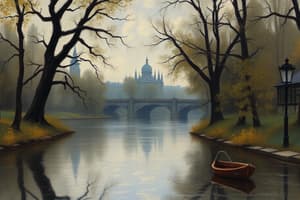Podcast
Questions and Answers
O que são fontes escritas e quais são alguns exemplos?
O que são fontes escritas e quais são alguns exemplos?
São registros escritos ou em forma de texto do passado. Exemplos incluem: documentos oficiais, certidões, registros de terras, cartas, jornais, revistas, sites, blogs, etc.
O que caracteriza as fontes orais? Dê um exemplo.
O que caracteriza as fontes orais? Dê um exemplo.
São histórias contadas, narrativas que passam de geração em geração. Um exemplo são os relatos de sobreviventes de guerras e catástrofes naturais.
Qual das seguintes opções NÃO é considerada uma fonte visual ou iconográfica?
Qual das seguintes opções NÃO é considerada uma fonte visual ou iconográfica?
- Relatos de sobreviventes de guerra (correct)
- Caricaturas e charges
- Pinturas rupestres
- Telas que figuram personagens do cotidiano
O que são fontes audiovisuais? Forneça um exemplo.
O que são fontes audiovisuais? Forneça um exemplo.
Fontes _____ são as fontes originais, produzidas no próprio período estudado.
Fontes _____ são as fontes originais, produzidas no próprio período estudado.
Fontes _____ são as que decorrem das fontes primárias, feitas após o período do acontecimento.
Fontes _____ são as que decorrem das fontes primárias, feitas após o período do acontecimento.
A Lei Áurea, assinada em 1888, é um exemplo de fonte secundária.
A Lei Áurea, assinada em 1888, é um exemplo de fonte secundária.
O livro Casa-Grande & Senzala, de Gilberto Freyre, que aborda a abolição da escravidão, é considerado uma fonte primária.
O livro Casa-Grande & Senzala, de Gilberto Freyre, que aborda a abolição da escravidão, é considerado uma fonte primária.
Até o século XIX, apenas os documentos escritos emitidos pela administração oficial eram amplamente aceitos como fontes históricas.
Até o século XIX, apenas os documentos escritos emitidos pela administração oficial eram amplamente aceitos como fontes históricas.
Flashcards
What are written sources?
What are written sources?
Written records from the past, such as official documents, letters, and newspapers.
What are oral sources?
What are oral sources?
Spoken stories and narratives passed down through generations.
What are Visual or Iconographic Sources?
What are Visual or Iconographic Sources?
Images that represent lived realities of individuals in the past.
What are audiovisual sources?
What are audiovisual sources?
Signup and view all the flashcards
What are primary sources?
What are primary sources?
Signup and view all the flashcards
What are secondary sources?
What are secondary sources?
Signup and view all the flashcards
What is the Lei Aurea?
What is the Lei Aurea?
Signup and view all the flashcards
Casa-Grande & Senzala
Casa-Grande & Senzala
Signup and view all the flashcards
Study Notes
- Historical sources are classified by the period in which they were produced.
Types of Historical Sources
- Written sources: written records in past texts like official documents, land records, letters, newspapers, magazines, websites, and blogs.
- Oral sources: stories and narratives passed down through generations, such as accounts from war survivors or natural catastrophes.
- Visual or iconographic sources: image records that represent the realities experienced by individuals over time, like cave paintings, political and social figures, caricatures, and graphics.
- Audiovisual sources: sources that combine image and sound. These include movies, series, and TV commercials.
Primary and Secondary Sources
- Primary sources are original sources produced during the period being studied.
- Secondary sources come from primary sources and are created after the event.
- The "Lei Aurea" which abolished slavery in Brazil, approved in 1888 and signed by the princess of Brazil, is a primary source because it was produced during that time.
- "Casa-Grande & Senzala" by Gilberto Freyre is a secondary source because the author lived through the 20th century after the Lei Aurea.
- Only written documents issued officials were accepted as historical sources until the 19th century.
- Historians began using different sources over time, giving voice and telling the stories of those unheard for a long time.
Studying That Suits You
Use AI to generate personalized quizzes and flashcards to suit your learning preferences.




